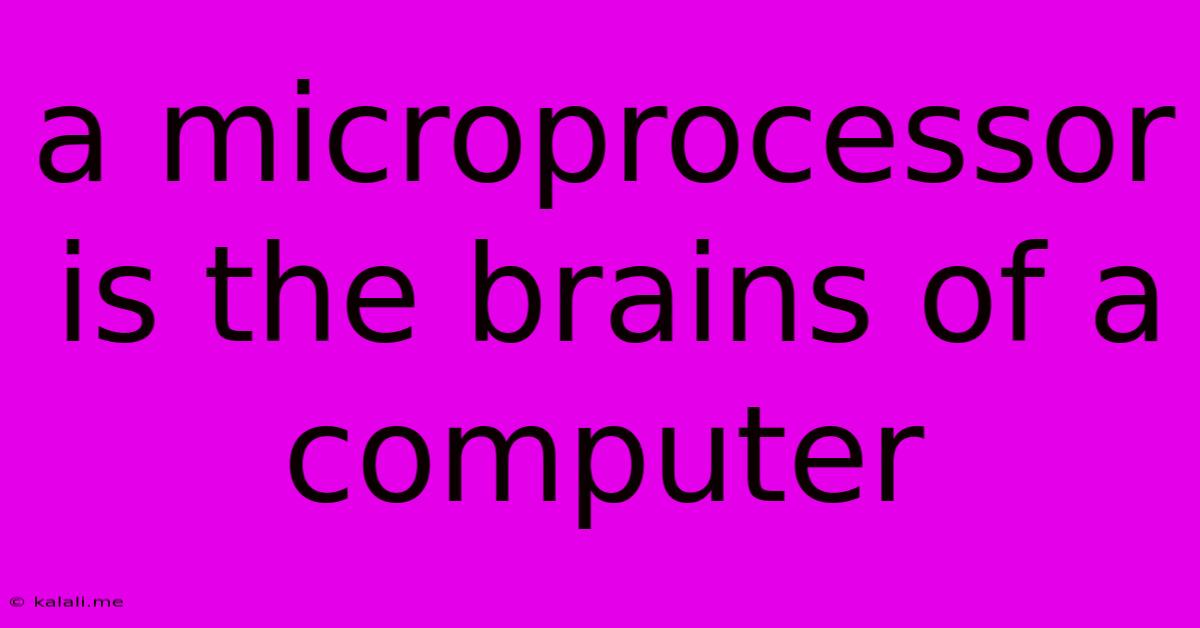A Microprocessor Is The Brains Of A Computer
Kalali
Jun 13, 2025 · 3 min read

Table of Contents
A Microprocessor: The Brains of Your Computer
Meta Description: Discover the heart of your computer! This article explains what a microprocessor is, how it works, its key components, and why it's considered the "brains" of every computing device. Learn about different types and the impact of Moore's Law on its evolution.
The modern world runs on computers, and at the heart of every computer, from smartphones to supercomputers, lies a tiny yet incredibly powerful component: the microprocessor. Often referred to as the "brains" of the computer, the microprocessor is the central processing unit (CPU) responsible for executing instructions and performing calculations. Understanding its function is key to understanding how computers work.
What is a Microprocessor?
A microprocessor is a single, integrated circuit (IC) containing millions or even billions of transistors. These transistors act as tiny switches, controlling the flow of electrical signals and performing logical operations. These operations are the foundation of all computations a computer performs, from simple arithmetic to complex simulations. The microprocessor's architecture dictates how it processes data, influencing its speed and efficiency.
Key Components of a Microprocessor
Several key components work together within the microprocessor:
- Arithmetic Logic Unit (ALU): This is the "calculator" of the microprocessor, performing arithmetic operations (addition, subtraction, multiplication, division) and logical operations (AND, OR, NOT).
- Control Unit (CU): This component acts as the "director," fetching instructions from memory, decoding them, and coordinating the execution of those instructions by other components.
- Registers: These are high-speed storage locations within the microprocessor used to hold data being processed. They provide faster access than the main memory (RAM).
- Cache: This is a small, very fast memory that stores frequently accessed data. Accessing data from the cache is significantly quicker than accessing it from RAM, greatly improving performance.
How a Microprocessor Works: The Fetch-Decode-Execute Cycle
The microprocessor operates through a continuous cycle:
- Fetch: The control unit retrieves an instruction from memory.
- Decode: The instruction is decoded to determine what operation needs to be performed.
- Execute: The ALU or other components perform the specified operation.
- Store: The result of the operation is stored in a register or memory location.
This cycle repeats continuously, processing thousands or even millions of instructions per second.
Types of Microprocessors
Microprocessors vary in their architecture, clock speed, core count, and other specifications. Some common types include:
- x86 processors: Dominant in desktop and laptop computers, known for their compatibility and power.
- ARM processors: Widely used in mobile devices, embedded systems, and servers, valued for their energy efficiency.
- RISC-V processors: An open-source instruction set architecture gaining popularity for its flexibility and potential for innovation.
Moore's Law and Microprocessor Evolution
The exponential growth in microprocessor capabilities over time is largely attributed to Moore's Law, which observes that the number of transistors on a microchip doubles approximately every two years. This continuous miniaturization has led to increasingly powerful and energy-efficient microprocessors, driving advancements across numerous technologies.
The Future of Microprocessors
The future of microprocessors involves continued advancements in areas such as:
- Increased core counts: Multi-core processors allow for parallel processing, enhancing performance.
- Improved energy efficiency: Reducing power consumption is crucial for mobile and embedded systems.
- Specialized architectures: Developing processors optimized for specific tasks like artificial intelligence (AI) and machine learning (ML).
In conclusion, the microprocessor is the fundamental building block of modern computing. Its complex design and continuous evolution are responsible for the incredible technological advancements we see today, impacting every aspect of our lives. Understanding its function provides a deeper appreciation of the intricate workings of the digital world around us.
Latest Posts
Latest Posts
-
Largest Gland In The Human Body
Jun 14, 2025
-
Lcm Of 5 7 And 2
Jun 14, 2025
-
Which Of The Following Is Not Part Of The Pelvis
Jun 14, 2025
-
Which One Of The Following Is A Pure Substance
Jun 14, 2025
-
What Is The Formula For The Intelligence Quotient
Jun 14, 2025
Related Post
Thank you for visiting our website which covers about A Microprocessor Is The Brains Of A Computer . We hope the information provided has been useful to you. Feel free to contact us if you have any questions or need further assistance. See you next time and don't miss to bookmark.